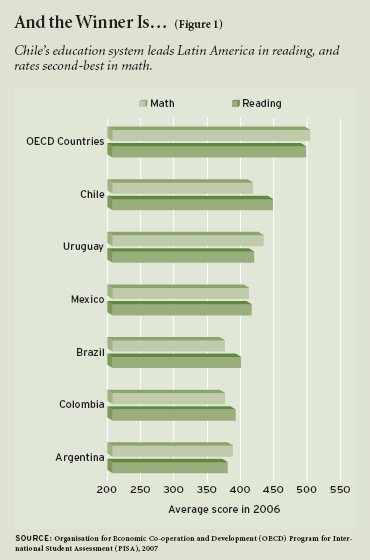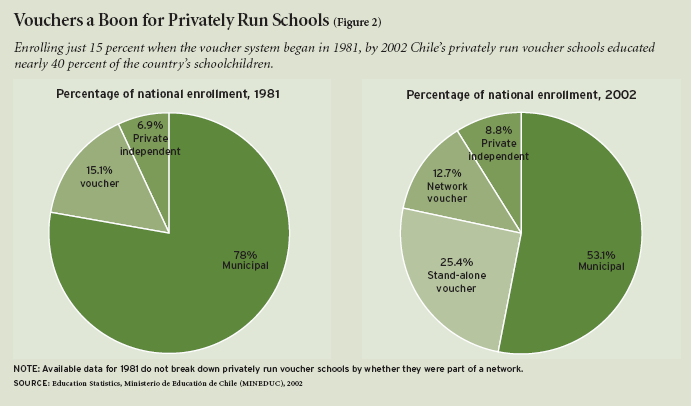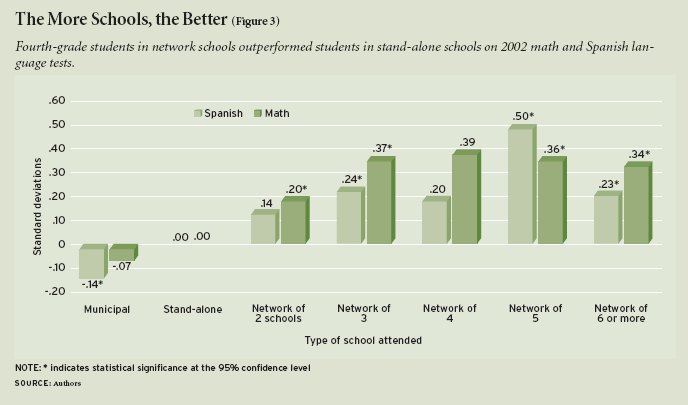 On international tests, Chilean students in 2006 outperformed those of all other Latin American countries in reading and were second only to Uruguay in math (see Figure 1). But although Chile’s educational performance appears to outstrip that of its closest competitors, the country’s educational system has become highly controversial among scholars throughout the western hemisphere. By and large, the education systems of most Latin American countries are all but ignored by outside scholars. However, the Chilean system has generated a veritable cottage industry of research scholarship that has yielded a range of conflicting findings.
On international tests, Chilean students in 2006 outperformed those of all other Latin American countries in reading and were second only to Uruguay in math (see Figure 1). But although Chile’s educational performance appears to outstrip that of its closest competitors, the country’s educational system has become highly controversial among scholars throughout the western hemisphere. By and large, the education systems of most Latin American countries are all but ignored by outside scholars. However, the Chilean system has generated a veritable cottage industry of research scholarship that has yielded a range of conflicting findings.
The explanation for this odd fact: since 1981 Chile has had a more comprehensive school choice system than any other country in the world, as well as a system of publicly available information on student test performance. Scholars have thus seen Chile as a place to test theories of school choice. Do students with vouchers learn more in private schools or in those run by municipalities? What is the impact of a voucher system on equality of educational opportunity? The answers to these and related questions have been just about as varied as the number of scholars who have inquired into the matter. On balance, the bulk of the research shows a small educational advantage for students who attend privately operated voucher schools rather than municipal ones. But hardly any study looks at differences among the voucher schools, and none has examined differences between private schools in networks and those that operate on a stand-alone basis. Yet interest in school networks has escalated since many operators of charter schools in the United States have begun to expand their operations beyond a single school. Some have argued that this is the ideal way for connecting school choice to school improvement. If effective schools can expand either by setting up or by “franchising” other schools, school quality can gradually improve. But others say that the formation of networks of schools will lead to a standardization that will undermine the vitality of individual school communities.
Chile is an ideal place for exploring these questions. In 2002, only 53 percent of students were still being educated in municipally run schools, which nonetheless received a good deal of their funding from the vouchers paid for by the national government. Another 9 percent of students attended fee-based private schools that were independently operated and received no government assistance whatsoever. For the most part, these were schools with well-established reputations that served the country’s upper class. The remaining students attended what might be called voucher schools, because the schools, while private, had been since 1981 heavily dependent on the subsidy that the schools received from the national government for each student they enrolled. This sector is the fastest growing segment of the Chilean educational system.
Like American charter schools (see “Brand-Name Charters,” features), Chile’s privately run voucher schools may be part of a larger organization or school network, or operate on their own. Most schools are of the stand-alone or “mom-and-pop” variety: 25 percent of all students in Chile attend such schools. But another 13 percent of students attend schools that are part of a network of two or more schools.
The schools, inside and outside of networks, vary from one another in many ways. Some are operated by teachers who once worked in municipal schools. Others are run by business entrepreneurs. Fifty-nine percent of the network schools are run by nonprofit entities, either religious or secular. For-profit organizations operate the remainder. Some schools as well as some networks are religious. Most networks, and especially those in rural areas, consist of just two or three schools. Only about 20 percent of primary (K–8) private voucher school students attend schools that belong to networks that have more than three schools (see sidebar).

Proponents of school networks say that the networks facilitate the flow of information (such as research on best practices) among schools and provide political benefits, credibility, and legitimacy in the eyes of the community. They argue that larger schooling operations have more access to private investments and loans to expand than smaller operations do. Supporting this view, research on public charter schools in the United States indicates that well-established charter school networks can build credibility for fund-raising more easily than stand-alone charter schools can. The underlying hypothesis is that, all else bring equal, the more a schooling organization facilitates transactions between members of a school’s community, the better the school’s performance. The research conducted so far shows that stand-alone charter and brand-name schools, like their district counterparts, vary widely in quality.
Critics of school networks fear unintended negative consequences. They argue that large centralized operations create hard-to-manage bureaucracies and make it difficult to maintain order and create a sense of community among students, parents, teachers, and administrators. Opponents also claim that large schooling operations grant too much authority to administrators and other professionals far removed from the classroom. Some critics are concerned that consolidation encourages standardization. For instance, they maintain that school networks must establish a brand to be successful, which necessitates relatively uniform operations and services from site to site. They argue that this branded approach to education stifles innovation.
Very little factual information is available to sort out the credibility of these claims and counterclaims. It is thus of interest to examine the Chilean experience, where both network and stand-alone voucher-subsidized schools have been operating for several decades. Information on more than one-quarter million students who were 4th graders in 2002 allows us to compare Spanish language and mathematics achievement in network and stand-alone voucher-subsidized schools. Our findings suggest that network schools in Chile are more effective than stand-alone schools, and that larger networks tend to outperform smaller networks. While we cannot be certain whether the higher performance of network schools is because good schools were the ones to expand or whether networking, by itself, had a positive impact, our results nonetheless add considerably to the sparse information currently available on a question of substantial policy interest.
| The Many Faces of Voucher Schooling
Schools that receive government vouchers in Chile vary from for-profit network schools to small stand-alone schools. Here are three examples: For-profit network Sociedad Educaciónal Tte. Dagoberto Godoy Ltda. operates seven schools: two are located in poor municipalities, four are in lower-middle-class municipalities, and one serves a middle-class municipality in Santiago. Owner Walter Oliva’s parents were teachers who founded most of the network’s schools in the 1970s and early ’80s. A successful entrepreneur, Oliva also has business investments in agriculture; he manages the schools and his other businesses from his headquarters in Santiago. Standardized test scores for these schools are high compared to the national average and very high compared to schools with similar students. Nonprofit Catholic network Congregación Salesiana operates thirteen schools: five in Santiago, four in the south of Chile, and three in the central part of the country. The smallest school in the network serves around 600 students, the largest more than 1,700. Although most Congregación Salesiana schools outperform similar schools in Chile, test scores vary widely across the network. For-profit stand-alone school Franz Liszt Nº 784 serves 240 students in Maipú, a middle-class municipality in Santiago. Owner Marina Goméz Bustamente taught for several years before buying this school after former owner and principal Maria Ester Gajardo Martinez passed away. Test scores are low compared to schools with similar students. |
School Reform in Chile
During the 1980s, the Chilean government decentralized the administration of schools, transferring responsibility for public school management from the Ministry of Education to municipalities (recognized neighborhoods in Chile around which municipal services are organized). The government also changed the education financing scheme. Municipalities began to receive funding from the central government according to the number of students who chose to attend the municipal schools. Any enrollment loss had a direct effect on their education budgets. Equally important, privately run schools that had not charged tuition began receiving the same per-student voucher as the public schools. Tuition-charging (elite) private schools mostly continued to operate without public funding.
Despite the parity in funding, significant differences remained between municipally run schools and privately run voucher schools. First, starting in 1994 municipal elementary schools were not allowed to charge parents fees, while all privately run voucher schools could. Second, municipal schools were required by law to accept all who applied. Private voucher schools, in contrast, were allowed to consider results from admissions tests and parent interviews when making admission decisions. Third, municipal schools had to comply with labor laws that made it virtually impossible to fire a low-performing teacher. Privately run voucher schools had greater freedom to terminate employment. In addition, municipal school teachers received salary increases incrementally, based on years of experience. There were no rules with regard to incremental salary increases in the private school sector.
The policies sparked a movement of students from municipal to previously existing private schools as well as the establishment of new institutions. In 1981, 15 percent of the nearly 2.9 million Chilean K–12 students had been attending private schools that received some public subsidy, and another 7 percent attended elite, unsubsidized private schools. By 1990, 34 percent of students attended privately run voucher schools; by 2002, enrollment in such schools reached 38 percent of the roughly 3.4 million in total enrollment (see Figure 2). The trend continued after 2002, the year in which the data for this study were collected. By 2005, 43 percent of students were enrolled in privately run voucher schools. As indicated above, about one-third of the voucher schools belong to networks, while the remaining two-thirds operate independently.
Beginning in 2003, after our data were collected, the Chilean government sought to alter several features of the system, although not all of the changes have been fully implemented: Rather than providing vouchers at a flat rate, voucher amounts are to be tied to family income. Private voucher schools can no longer select students in primary school; for secondary school admission, they can administer tests, but they cannot conduct parent interviews. In addition, Congress recently passed legislation that will hold schools accountable for student achievement and improvement over time.
The political debate continues. In 2006, widespread student protests of inequalities in the education system prompted debate over whether entrepreneurs should be able to own and run private voucher schools for profit. Proposed legislation, which initially prohibited for-profit education organizations, now would require that such entities make available to the public information on their profitability as well as their use of voucher funds.

Data and Methodology
Our study is based on student-level data from Chile’s national standardized test, Sistema de Medición de la Calidad de la Educación (Educational Quality Measurement System—SIMCE), which assesses students in grades 4, 8, and 10 in language, mathematics, history and geography, and natural sciences. In 2002, SIMCE evaluated 274,863 4th graders. Complementing student test scores are parent and teacher questionnaires, which include socioeconomic and environmental information on the students, their families, their peers, and their schools.
Because we lacked complete data for some schools, our study includes 252,202 students. Fifty-eight percent of the students were attending municipal schools, 24 percent were attending stand-alone schools, and 18 percent were attending network schools. In addition to separating out municipal and stand-alone private schools, our analysis subdivides the network schools into five groups—those that are in networks of two, three, four, five, and more than five schools—for a total of seven categories. (We have excluded information from the elite, independent schools that receive no government subsidy.) We compare the test scores of students in each of the seven categories, taking into account differences in the students’ socioeconomic characteristics, including parent schooling, self-reported household income, the number of non-school books in the home, and the quality of the peer groups (calculated by averaging family background and home resources for all students in the classroom). We also included some school-level control variables—whether or not the school was located in a rural area, the total number of students per school, and the average monthly tuition a school charges.
If these variables fully account for differences in student and peer demographics across the various categories of schools, then this strategy will provide unbiased evidence on the relative effectiveness of municipal, stand-alone, and network schools. We cannot account for other factors that could be significant. For example, the average student attending a privately run voucher school, whether network or stand-alone, may have parents who place a higher value on education than those of the average student attending a municipal school. Because we do not have a measure of parent commitment to education, we may confuse the effect of having a committed parent with that of attending a private school. Similarly, the “brand name” value attached to network schools may enable them to select more-qualified students, on average, than their independent counterparts.
As a result, simple comparisons of student outcomes in municipal, stand-alone, and network schools might give misleading estimates of the impact of schools on student achievement, even after adjusting for the measured characteristics of the students who attend each type of school. In order to correct for this selection bias, we restrict our analysis to differences across students in the type of school they attend that result from the types of schools available to them. More specifically, we assume that an individual’s probability of choosing a given school type is affected by the school density (that is, the number of schools per square kilometer) of each type in her municipality. All else being equal, students are more likely to choose schooling alternatives that are more densely concentrated in their municipalities. The crucial assumption made by our method is that school choice is influenced by local school supply, but school densities at the community level do not directly influence student achievement.
Though every precaution has been taken to make the comparison exact, it is still possible that our results overestimate the benefits of privately subsidized schools over municipal ones. For example, it is possible that voucher schools are to be found in greater density in higher income areas, where more parents are willing to pay additional fees for their children to attend higher-quality schools. To the extent that is happening, our results could be biased toward finding greater voucher benefits than is actually the case. For that reason, our comparisons between private and municipal schools should be interpreted cautiously. However, that potential source of bias is unlikely to affect comparisons between stand-alone private schools and network ones, the main focus of this analysis.

Results
We report our results in terms of standard deviations of student test scores. The difference in performance between American 4th and 8th graders on the National Assessment of Educational Progress is about one full standard deviation, suggesting that students improve by one quarter of a standard deviation each year. Although comparable measures of the rate of student learning are not available for Chile, researchers studying the Chilean school system typically consider a difference in student achievement of 10 percent of one standard deviation to be a small to moderate effect. Without accounting for any differences in students’ socioeconomic status, the Spanish language and mathematics test scores of students who attend network schools are considerably higher than the scores of those attending stand-alone schools. After controlling for student and peer attributes and for selection bias, we still find a substantial positive and statistically significant effect of attending a network school on student achievement. Students at network schools score 19 percent and 25 percent of a standard deviation higher than students at stand-alone schools in Spanish language and math, respectively. We also find that students at municipal schools do significantly worse than students at stand-alone schools on achievement tests (19 percent and 16 percent of a standard deviation in Spanish language and math, respectively), although, as discussed above, we are less confident in these results because of the difficulties of accounting for the selection of students into and by private schools.
Although these results provide some evidence of the effectiveness of school networks, a more precise analysis is needed to understand the optimal size of a network. We examined whether larger networks are more effective than smaller ones and found that, both with and without correcting for student and peer socioeconomic characteristics and selection bias, students at schools that are part of networks of three or more schools consistently outperform students at schools in networks of only two schools.
Figure 3 shows the results from our estimations. Students in schools in larger networks generally learned more than students in stand-alone schools. The results for Spanish language achievement show students in schools in networks with three schools learn 24 percent of a standard deviation more, those in networks of five schools learned 50 percent of a standard deviation more, and those in networks of more than five schools learned 23 percent of a standard deviation more. The effects on mathematics achievement are similar. Students who attend schools in networks with three schools learn 37 percent of a standard deviation more than students in stand-alone schools. The percentages for those in networks of five and more than five schools are 36 and 34, respectively.
Prior research in Chile and in the United States has demonstrated that, all else being equal, Catholic schools outperform public schools and other private schools. Since some of the network schools were affiliated with Catholic churches, that fact could be the explanation for the apparent positive benefits that come from networking. To determine whether that was the case, we checked whether the school owners were Catholic. Only 13 percent of the students attended such schools, however. And after adjusting for Catholic affiliation, the differences between network and stand-alone schools remained large and significant. In other words, the superior performance of network schools is not driven by the number of them that are Catholic.
Policy Implications
This paper compares the academic achievement of 4th graders in municipal schools, stand-alone schools, and network schools. Controlling for individual and peer characteristics as well as selection bias, we find that students in network schools outperformed those in stand-alone schools in both Spanish language and math. The stand-alone schools outperformed municipal schools but not by as large a margin. It also is of interest that students generally performed better in networks of large size. Most clearly, those in networks that contained three or more schools generally outperformed those in networks with only two schools.
Possible explanations for the positive school network effect include the substantial benefits of scale for employing education professionals and administrators, the bulk purchases of supplies and equipment, and the costs of implementing innovations in the curriculum. School networks may also benefit from greater access to credit and private investment than that extended to small individual schools in Chile. In addition, it may be that operating within a larger communal organization reduces agency problems; encourages interactions between parents, teachers, administrators, and students; and influences the development of professional school communities.
Of course, it is also possible that good schools are invited to join networks, while weaker schools are left on their own. In a competitive schooling environment, low-quality schools may be unable to attract students and additional resources needed to expand operations.
The results of this paper add evidence to the debate in the United States over the desirability of creating networks of charter and voucher schools. The findings provide some ground for optimism about the effects of networking on student achievement. Policies that provide incentives for schools to establish a network or to be managed by an organization that runs a network of schools may have the potential to increase educational outcomes.
Gregory Elacqua is professor at the Universidad Diego Portales in Santiago, Chile, and former policy advisor to the Minister of Education of Chile. Dante Contreras is senior researcher at the United Nations Development Program (UNDP) Chile and associate professor, Universidad de Chile. Felipe Salazar is researcher at the Universidad Diego Portales.


